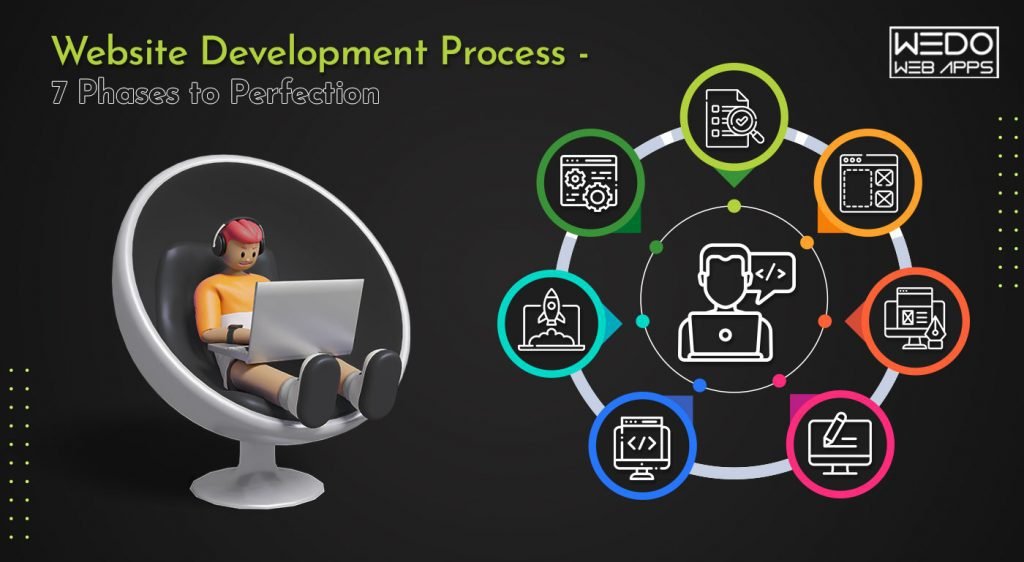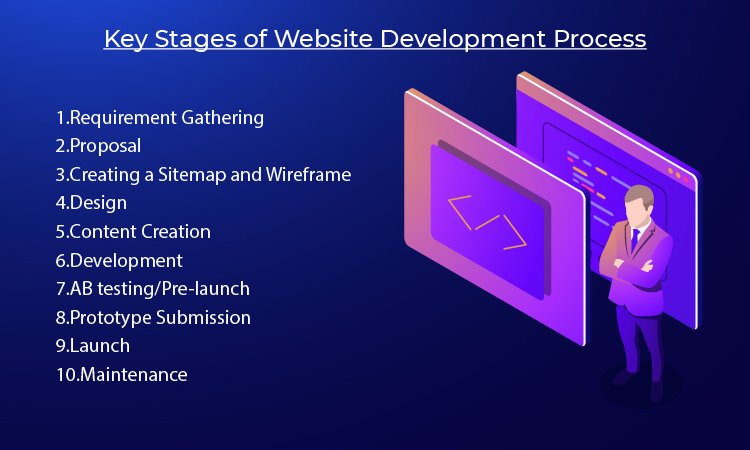17 Oct, 2022 | Responsive Web Design Services
Website Development Process - 7 Phases to Perfection

Responsive Websites and their Importance?
Before diving deeper into the phases of web development, we earlier mentioned responsive websites. What are they? Why are they Important? A responsive website is the one that automatically scales its elements and content as per the screen sizes on which it is operated. The ultimate goal of a responsive website is to eliminate the unnecessary hassle of scrolling, resizing, panning, or zooming that occurs when the websites are not optimized for different screen sizes. A responsive website is essential because it may cost you potential and long-term customers if your website is not optimized for different screen sizes. In addition, they may get frustrated with trying to figure out what they are looking for. Hence, it is crucial to develop a responsive website for the growth of your customer base.Why should you invest in Building Responsive Websites?
The latest trends suggest that it is a wise decision to keep in mind both desktop and mobile visitors. The number of mobile visitors is now greater than desktop visitors, and this will continue to grow over time. Hence, here are the following reasons why you should invest in Responsive Websites:- Cost-effectiveness
- Flexibility
- SEO gains
- Ease of management
- Improved User experience
Key Stages of Website Development Process
 Designing a website, an application, or any web-based product requires dedication, planning, and organization. A web development process incorporates different skills and disciplines to design and develop a functional website. Different stages of web development include graphic design, user interface design, user experience design, coding, and search engine optimization. In short, it is a step-by-step process to develop a responsive website.
Following are the steps that will help you understand the overall design process:
Designing a website, an application, or any web-based product requires dedication, planning, and organization. A web development process incorporates different skills and disciplines to design and develop a functional website. Different stages of web development include graphic design, user interface design, user experience design, coding, and search engine optimization. In short, it is a step-by-step process to develop a responsive website.
Following are the steps that will help you understand the overall design process:
Step 1: Requirement Gathering
Requirement gathering is one of the most important steps of the overall development process. Understanding the scope, expectations, and available resources makes both the developer and the customer ready for future success. This is important because any type of business should be started with the aim of a win-win situation for both parties. There are a few types of requirements you should keep in mind during this step: > Technical Requirement: While gathering the project requirements, think of every technical aspect related to it. Domain Name, Web Hosting, CMS, and email should be the primary requirements and each priced accordingly. If the client is not educated about the technical stuff, offer them to do it with their company credit card. > Provide a Rough Estimate: Once you have gathered all the technical requirements, you should have an approximation of the 10% of the entire fee in your mind. Remember, when you tell the customer your estimate, they will try to convince you for low prices. In that case, either convince them to scale down the project size or reduce any specific functionality that costs higher. Do not get convinced or go below your basic fee.Step 2: Proposal
Formalizing things is essential. Call it a contract, estimate, proposal, or anything else, but it is vital to have a document. The fact is to have a document for both the developer and the client to understand what is being delivered under the estimated timeline and price. A proposal is also helpful in project management. It helps project managers understand the client's requirements to avoid any misconceptions during the development. A minimum project proposal should include an introduction of the project, expectations, sitemap and Wireframe, functionalities, development process, deadline, and fee.Step 3: Creating a Sitemap and Wireframe
A sitemap means creating your website's architecture and organization that features the pages, placement, and relationship with other website pages. It only includes the elements related to users and web crawlers. It includes defining and organizing web content that helps developers and designers dive deep into planning the look and functionality of each page. The Wireframe is the layout of each website page. It outlines all the elements from a headline to CTAs and subscription boxes. Typically web design companies create the Wireframe for both desktop and mobile versions. Creating a sitemap and Wireframe will enable you to plan the buyer's entire on-site journey, adjust the features and functionalities, and picture the final result.Step 4: Design
Now is the time for the most complex part. Once you have roughly sketched the sitemap and Wireframe, it is time to determine the look and feel of the website. Using the information gathered up to this point, you can plan to design your website's user interface to finalize your website's complete look. It would not be wrong to say that 90% of the website visitors bounce due to poor website design. This is where your final website look comes into play to ensure your online presence is consistent with all other website elements. The website designers will apply your company logo, preferred color palette, icons, images, and other elements to strengthen your website's look.Step 5: Content Creation
Done with creating the framework of the website? It's now the time to get started with the foundation of the web design process. Yes, that is content creation. If your website's front-end is captivating, then you can easily catch the attention of the visitors. If the content of your website is worthy and alluring, then you can easily retain the customers to make a purchase. Website content is the most value-adding website design trend in 2021 and will remain the same in the future as well. Apart from driving customers, it also boosts the website's visibility for search engine optimization. Hence, never try to ignore the content part if you want your design process to be smooth and effective.Step 6: Development
Finally, it is time for the developer to show the technical skills for building a functional website. This involves the actual website development It is bifurcated into two parts: front-end development and back-end development. Front-end Development - The designs made in the above stages are now transformed into the active elements of the website. For building a website, web developers integrate components and functions to the skeleton of the website using framework and development tools. HTML, CSS, and generally JavaScript are used by web developers to create a responsive website. However, if you want to stay with the competition, user-friendly mobile website development is also recommended. Back-end Development - This stage involves developing the actual features of the website. While the front-end designs the visual elements for the user side, the back-end codes the instructions to make all the elements function properly. This is the process of creating the server-side website, developing databases, coding the website logic, and integrating the client and server-side functions. If you are a non-technical person, it is highly recommended to avail of responsive website design services from an established website development company.7. AB testing/Pre-launch
Once the website is developed, it undergoes rigorous tests to eliminate any bugs present in the website. The QA testers repeatedly perform various tests like unit testing, load testing, and stress testing to ensure the website's compatibility, performance, usability, and functionality. Being a responsive web design company, our quality assurance testers perform testing of your website's usability and functionality across:- Cross-browser testing: Testing the website on the latest versions of the major search engines like Internet Explorer, Google Chrome, Safari, Firefox, and Edge
- Cross-device Testing: On multiple devices like PC (Mac and Windows), Mobile (Android and iOS), and tablets.
- Functional Testing: Repeatedly checking the features according to the requirements to ensure they are successfully met.
8. Prototype Submission
However, before getting the website live on the Internet, client approval is absolutely important. Just after the testing is done, you should send the prototype link to the client so that they can test and review the website from their end. With the same submission, do remember to write the list of instructions for them to follow.9. Launch
Once the client is satisfied with the overall development, it is finally time to launch the website. It is a fascinating time for you and the client but still requires proper planning. Then, with the approval of all the designers, developers, other team members, and the stakeholders involved click deploy and send it to the live servers. It is a huge milestone achieved with the hard work of every team member, but the job is still not done - a website launched doesn't mean that the work is done. The next step is Maintenance.10. Maintenance
Even after the launch is done, our process continues. First, you may need to sort any additional bugs if encountered. Second, the user's needs constantly keep on changing over time, so your website needs to. We don't leave our clients stranded. We stay involved with our clients and keep a check on their website's progress. We ensure that the goals identified by the clients are hit. If not, we roll our sleeves and start working back to improve the functionality of their website. This was the website design process we follow for building websites with enticing user experience, responsiveness, and the latest features and functionalities. Website Development is essential. Agreed! But why is it crucial to develop a responsive website?In a Nutshell: Ready to ensign your Website?
Designing and developing a website and that too a responsive one is not an overnight job. It is clear that the steps mentioned above in the website design process take time, and all the steps need to be performed on point to get things done correctly. Strong communication between the client and the company helps to reduce it to some extent. If you follow the above steps with dedication, you will surely be able to create a robust digital presence on the Internet. Still, if you feel that you want a technical expert, you can always get in touch with the best Responsive Web Design company - WeDoWebApps LLC. We offer fantastic web design services within your budget and in minimal time. Whether you are looking for an eCommerce website, single-page web application, responsive web design, or development of any web-based product, you can always take help from the experts. Also, if you found the above points exciting and informative, share them with the people looking to develop excellent websites to stand out from their peers.Frequently Asked Questions
Website development is a complex process that involves several phases to ensure that the final product is user-friendly, visually appealing, and fully functional. The seven phases of website development process are:
- Planning: In this phase, the goals of the website are identified, the target audience is analyzed, and the website's requirements are defined.
- Analysis: In this phase, the website's features and functionalities are analyzed, and the website's structure and navigation are planned.
- Design: In this phase, the website's layout, color scheme, typography, and other visual elements are designed.
- Content Creation: In this phase, the website's content is created, including text, images, videos, and other multimedia elements.
- Development: In this phase, the website's technical aspects are developed, including coding, testing, and integration with other systems.
- Testing and Deployment: In this phase, the website is tested thoroughly to ensure that it meets the requirements and functions correctly. Once the website is tested, it is deployed to the production environment.
- Maintenance: In this phase, the website is regularly updated and maintained to ensure that it remains functional and secure.
The planning phase is one of the most important phases in website development as it sets the foundation for the entire project. During this phase, goals, objectives, and requirements are identified, and a detailed plan is created for the website's design, functionality, and content. Proper planning ensures that the website meets the needs of its target audience, is user-friendly, and achieves its intended purpose. Skipping or neglecting the planning phase can lead to confusion, wasted time, and resources, and ultimately result in a website that does not meet its intended goals. Therefore, it is crucial to allocate enough time and resources to the planning phase to ensure a successful website development project.
The planning phase is an essential part of website development as it lays the groundwork for the entire project. During this phase, the project team identifies the project's objectives, goals, requirements, and resources, along with a timeline and budget. Without proper planning, the website development process can be delayed, over-budget, and lead to unsatisfactory results. Therefore, the planning phase is crucial for ensuring that the website development project is successful, meets the client's expectations, and delivers a quality product.
Website developers can ensure that the website they are developing is user-friendly and easy to navigate by following some best practices. First, they should focus on creating a clean and simple design that makes it easy for users to understand the website's structure and navigate through it. Secondly, they should ensure that the website is responsive and can adapt to different screen sizes, making it accessible to a wide range of users. Thirdly, they should use intuitive navigation elements such as menus, breadcrumbs, and search bars to help users find what they are looking for quickly. Finally, they should test the website with real users to identify any usability issues and make necessary adjustments. By following these practices, website developers can create a user-friendly website that delivers a positive user experience.
There are several measures that website developers can take to ensure that their websites are secure and protected against cyber threats: Keep software up-to-date: Website developers should keep all software, including the operating system, web server software, and content management system, up-to-date with the latest security patches and updates. Use secure hosting: Choosing a secure hosting provider is critical in ensuring the security of a website. The hosting provider should offer strong security measures, such as firewalls and intrusion detection systems, to protect the website from cyber threats. Use HTTPS: HTTPS encrypts data in transit, making it more difficult for hackers to intercept sensitive information. Website developers should ensure that all pages on their website use HTTPS. Use strong passwords: Strong passwords are a fundamental aspect of website security. Website developers should use strong, unique passwords for all user accounts and should encourage their users to do the same. Implement access controls: Website developers should implement access controls to ensure that only authorized users can access sensitive information on the website. Regularly backup data: Website developers should regularly back up all website data to prevent data loss in case of a cyber attack or other disaster. Test website security: Website developers should regularly test the security of their website using tools such as vulnerability scanners, penetration testing, and code audits. By implementing these measures, website developers can significantly reduce the risk of cyber threats and ensure that their website is secure.

